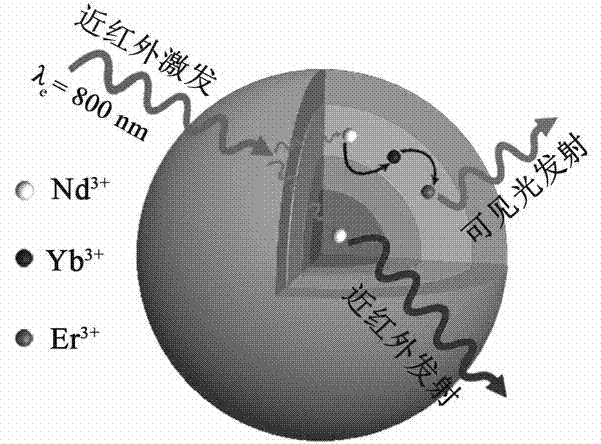Up/down conversion dual-mode fluorescent nanomaterial for Nd<3+> sensitization and synthesis method thereof
A fluorescent nanomaterial and fluorescence technology, applied in the field of up/down conversion dual-mode fluorescent nanomaterial and its synthesis, can solve the problems of reducing the excitation efficiency of excitation light, burning, and damage to the object under inspection.
- Summary
- Abstract
- Description
- Claims
- Application Information
AI Technical Summary
Problems solved by technology
Method used
Image
Examples
Embodiment 1
[0023] Example 1: NaGdF 4 :NdNaYF 4 NaGdF 4 :Nd,Yb,ErNaYF 4 Down-converting nuclear isolation shell 1 Up-converting shell 2 Protective shell 3 Excitation of Nd at 800 nm 3+ Preparation of sensitized up / down-converting bimodal fluorescent nanomaterials. Specific steps are as follows:
[0024] (1) Preparation of the shell precursor.
[0025] Preparation of the precursor of Y-OA (0.1 M): Take a 50 mL three-neck round bottom flask as the reaction vessel, add 2.5 mmol YCl in sequence 3 , 10 mL oleic acid (OA), 15 mL octadecene (ODE). Heating to 140 °C for 1 h under vacuum and magnetic stirring conditions finally yielded a clear and transparent precursor of Y-OA (0.1 M).
[0026] Preparation of Gd-OA (0.10 M), Nd-OA (0.10 M), Yb-OA (0.10 M), Er-OA (0.10 M), and Tm-OA (0.10 M) precursors: Gd-OA, Nd The preparation of -OA, Yb-OA, Er-OA, Tm-OA is similar to the preparation of the above-mentioned Y-OA precursor, and the above-mentioned YCl 3 Replaced by GdCl respectively 3 ,...
Embodiment 2
[0037] Example 2: NaYF 4 :Nd,Yb,TmNaYF 4 NaYF 4 :NdNaYF 4 Up-conversion nuclear isolation shell 1 Down-conversion shell 2 Protective shell 3 800 nm excitation Nd 3+ Preparation of sensitized up / down-converting bimodal fluorescent nanomaterials. Specific steps are as follows:
[0038] (1) Preparation of the shell precursor.
[0039] Preparation of the precursor of Y-OA (0.1 M): Take a 50 mL three-neck round bottom flask as the reaction vessel, add 2.5 mmol YCl in sequence 3 , 10 mL oleic acid (OA), 15 mL octadecene (ODE). Heating to 140 °C for 1 h under vacuum and magnetic stirring conditions finally yielded a clear and transparent precursor of Y-OA (0.1 M).
[0040] Preparation of Gd-OA (0.10 M), Nd-OA (0.10 M), Yb-OA (0.10 M), Er-OA (0.10 M), and Tm-OA (0.10 M) precursors: Gd-OA, Nd The preparation of -OA, Yb-OA, Er-OA, Tm-OA is similar to the preparation of the above-mentioned Y-OA precursor, and the above-mentioned YCl 3 Replaced by GdCl respectively 3 , NdCl 3...
Embodiment 3
[0051] Example 3: NaGdF prepared in example 1 4 :NdNaYF 4 NaGdF 4 :Nd,Yb,ErNaGdF 4 Down-converting core isolation layer, up-converting layer, passivation layer, core-shell structure nanocrystals have a hydrophobic surface, and modification of amphiphile molecules can make the obtained nanocrystals water-soluble, so that they have better biocompatibility . The resulting water-soluble nanocrystals are incubated with cells, and the nanoparticles enter the cells through endocytosis. Using the nanocrystals with both green and red visible light up-conversion fluorescence and near-infrared down-conversion fluorescence, we can perform multi-mode imaging of cells . In addition, by injecting the obtained water-soluble upconversion nanocrystals into mice through the tail vein, we can use the near-infrared downconversion fluorescence of nanoparticles for in vivo imaging. Since the excitation light source of the down-conversion near-infrared fluorescence of the nanoparticle is also...
PUM
 Login to View More
Login to View More Abstract
Description
Claims
Application Information
 Login to View More
Login to View More - R&D
- Intellectual Property
- Life Sciences
- Materials
- Tech Scout
- Unparalleled Data Quality
- Higher Quality Content
- 60% Fewer Hallucinations
Browse by: Latest US Patents, China's latest patents, Technical Efficacy Thesaurus, Application Domain, Technology Topic, Popular Technical Reports.
© 2025 PatSnap. All rights reserved.Legal|Privacy policy|Modern Slavery Act Transparency Statement|Sitemap|About US| Contact US: help@patsnap.com



